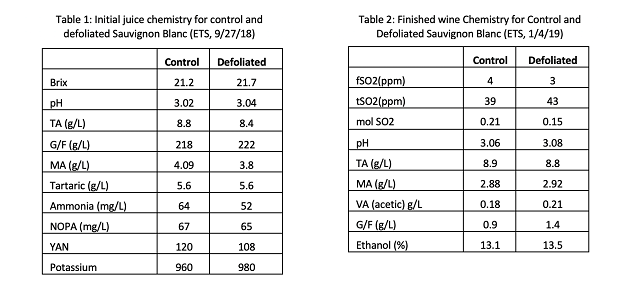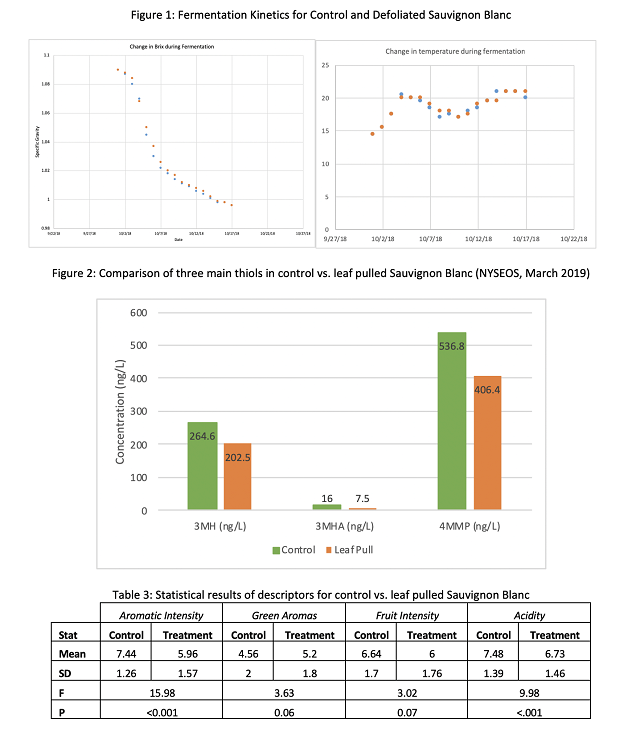The effect of early leaf pulling on thiol production in an Oregon Sauvignon Blanc (2018)
Scott Dwyer
Chemeketa Community College
Summary
Thiols have become a defining characteristic of aromatic Sauvignon Blanc wines. Early defoliation in the fruit zone has been shown to increase thiol production in South African Sauvignon Blanc (Šuklje et al 2104). In this study, leaves were removed from the east side of the fruit zone immediately after fruit set. Control rows had no leaf pulling. Resulting wines showed no differences in major chemistry, however wines with leaves pulled had lower concentration of thiols. Sensory analysis of resulting wines showed higher thiol intensity in control wines, with these wines also scoring significantly higher for aromatic intensity and acidity.
Introduction
Thiols have been shown to be important contributors to varietal character in Sauvignon Blanc (Tominga et al 1998). Šuklje et al (2014) showed that defoliation of the fruit zone just after fruit set (when berries were peppercorn size) led to wines with higher thiols and lower methoxypyrazine than controls. In the same study, sensory analysis by a trained panel showed that defoliation was associated with fruity descriptors such as tropical, passionfruit, grapefruit, and pineapple while the shaded control was associated with “green” descriptors such as cooked beans/peas, acidity and green pepper. Sukje et al (2014) undertook their work in the Overberg region of South Africa. This study aims to determine if these results are transferable to Oregon Sauvignon Blanc.
Methods
Immediately following fruit set, 100 % of leaves were pulled from the morning (east) side of the fruit zone in every other row of 4 identical rows of Sauvignon Blanc (Musque Clone 101-14 rootstock). Two rows had zero leaf pull throughout, though these rows were monitored for signs of disease or mildew pressure, neither of which presented during the growing season. The two lots were picked separately but identically on the same day into 4 x 16A non slotted macrobins (2 trial, 2 control). Immediately following harvest each bin was treated with 10mg/L SO2 and cooled overnight at 6°C. The following day each lot was pressed separately but identically with the addition of 37ppm SO2 and transferred to separate 500L stainless steel tanks. Juice was fined with 10 g/hL NBI (chitosan) and 12.9 g/hL bentonite, then cold settled (6°C) for 48 hours, after which they were racked into another set of 500L stainless steel tanks. After 48 hours the temperature increased to 12°C and both tanks were inoculated with 20g/hL Excellence FTH yeast (Lamothe Abeit) rehydrated in 30 g/hL Go Ferm. After 36 hours, signs of fermentation were present and YAN was increased by 100mg N/L using DAP. Both lots were fermented dry and 8g/hL Extralyse was added. Eleven days following Extralyse, 35ppm SO2 was added and both tanks were moved to storage at 12°C. Both tanks were stored with identical head space and are layered with argon once a week until sampling for analysis.
Wines were tasted at sensory session conducted in January 2019 by 27 winemakers and other production staff. No formal training was conducted, however informal standards of “bell pepper”, “passionfruit”, “grapefruit” and “boxwood” were provided. All samples were presented in clear glasses with random three-digit numbers. Two glasses were presented, each with 2 ounces of wine. Panelists were asked to identify which of the wines had more perceptible thiols (a paired difference test), then to evaluate each wine for aromatic intensity, green aromas, fruit intensity, and acidity. To prevent the dumping effect, panelists were also given two opportunities to write their own descriptors, in conjunction with the triangle test and in a comment box at the bottom of the scoring sheet.
Results
Juice chemistry is shown in Table 1 and finished wine chemistry is shown in Table 2. The difference in Brix found in the fruit (21.2 in control vs. 21.7 in treated) translated to a difference in alcohol in the finished wine (13.1 vs. 13.5%). All other juice and wine chemistry measurements are very similar. Fermentation progressed at the same rate in both tanks with little difference in temperature (Figure 1).

Concentration of three main thiol compounds, 3MH, 3MHA and 4MMP were measured by NYSEOS in March of 2019 (Figure 2). All three compounds were found above the sensory threshold of detection in both treatments. Levels of all three compounds were higher in the control than the leaf pull treatment. In a paired difference test, 22 of 27 respondents chose the control wine as having higher perceptible thiols with comments that both wines had intense thiols, citing citrus, passionfruit and grapefruit as descriptors that helped make their choice. This is a significant difference (Z=2.46, p=0.0069). Table 3 lists results of repeated measures ANOVA for each descriptor. The control wine scored higher for both aromatic intensity and acidity, though the means for these descriptors were very similar, indicating a consistent but small difference.

Preliminary Conclusions
In this study, partial defoliation led to a decrease in measurable thiol concentration as well as perception to thiol intensity. This is contrary to the expected findings, as outlined by Šuklje et al (2014).
References
- Šuklje, K., G. Antalick, Z. Coetzee, L.M. Schmidtke, H. Baša Česnik, J. Brandt, W.J. du Toit, K. Lisjak, and A. Deloire. (2014) “Effect of Leaf Removal and Ultraviolet Radiation on the Composition and Sensory Perception of VItis ViniferaL. Cv. Sauvignon Blanc Wine: Light, Ultraviolet Radiation and Wine Composition.” Australian Journal of Grape and Wine Research 20(2): 223–33.
- Tominaga, T., C. Peyrot des Gachons, and D. Dubourdieu. (1998) A new type of flavor precursors in Vitis vinifera L. cv. Sauvignon blanc: S-cysteine conjugates. Journal of Agricultural and Food Chemistry 46: 5215–5219.
